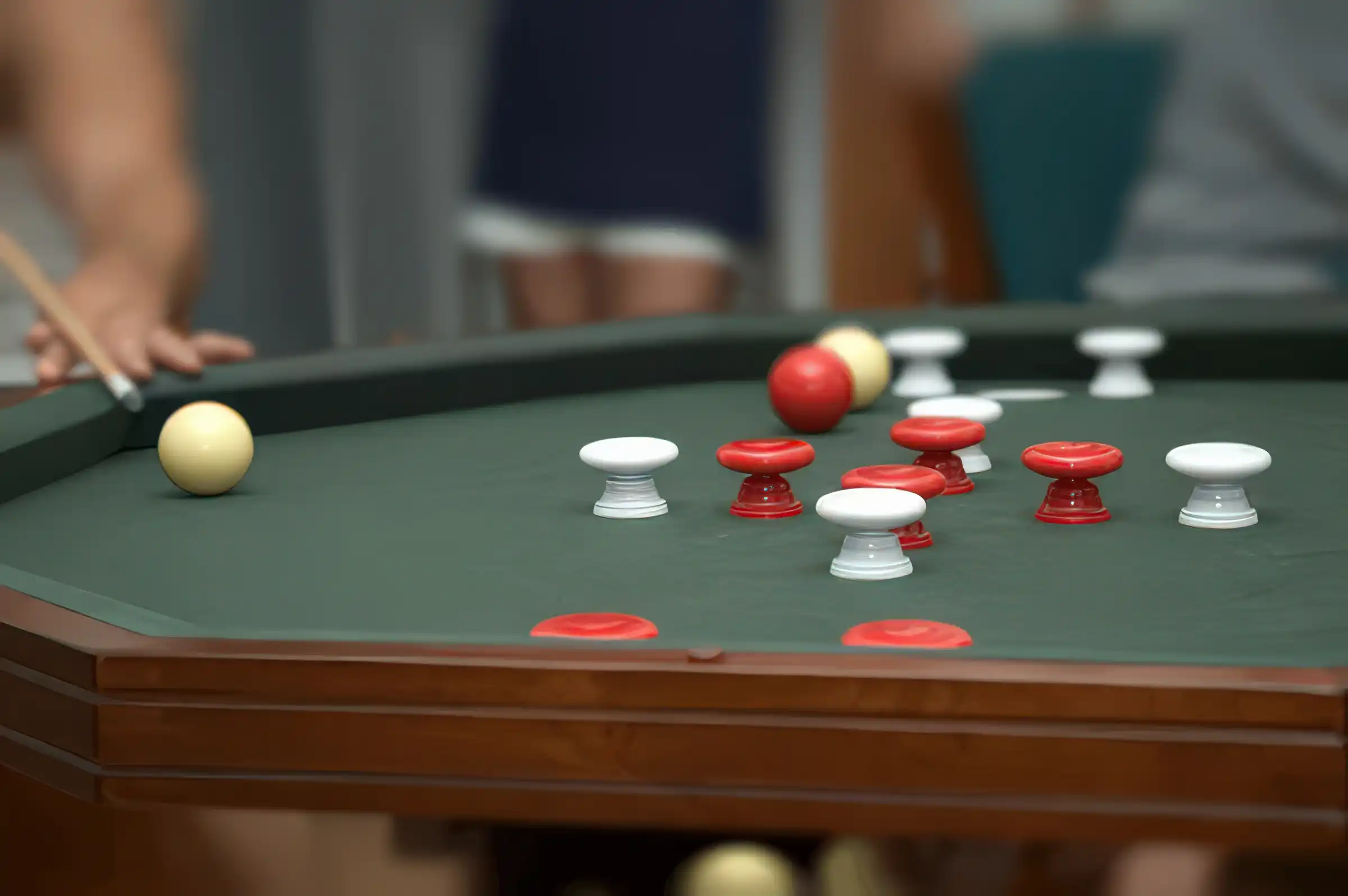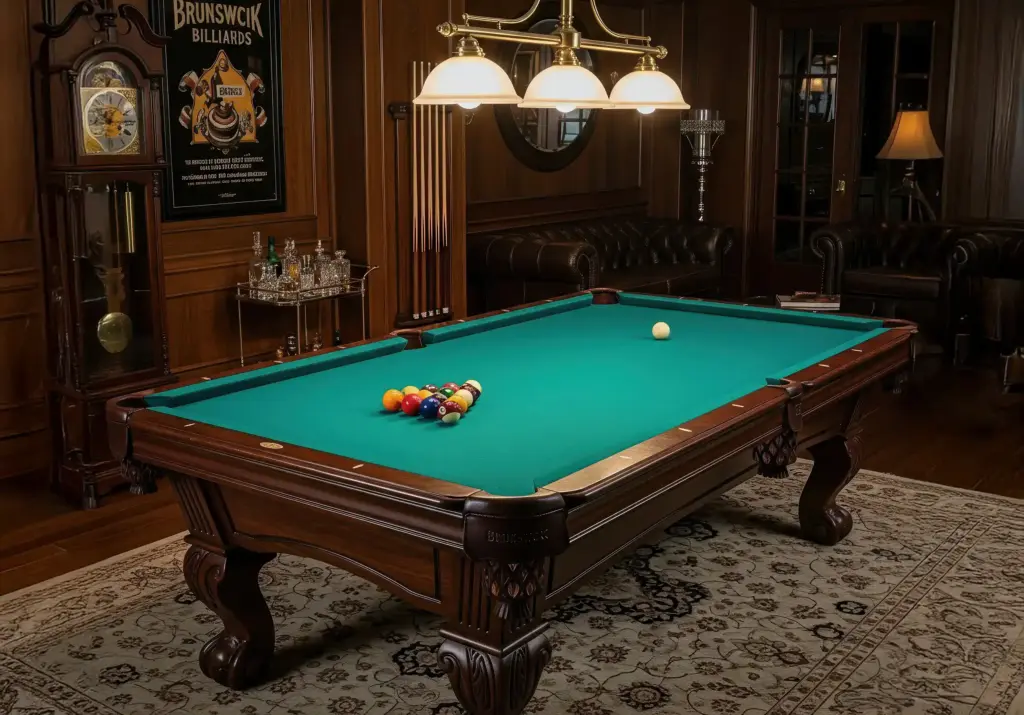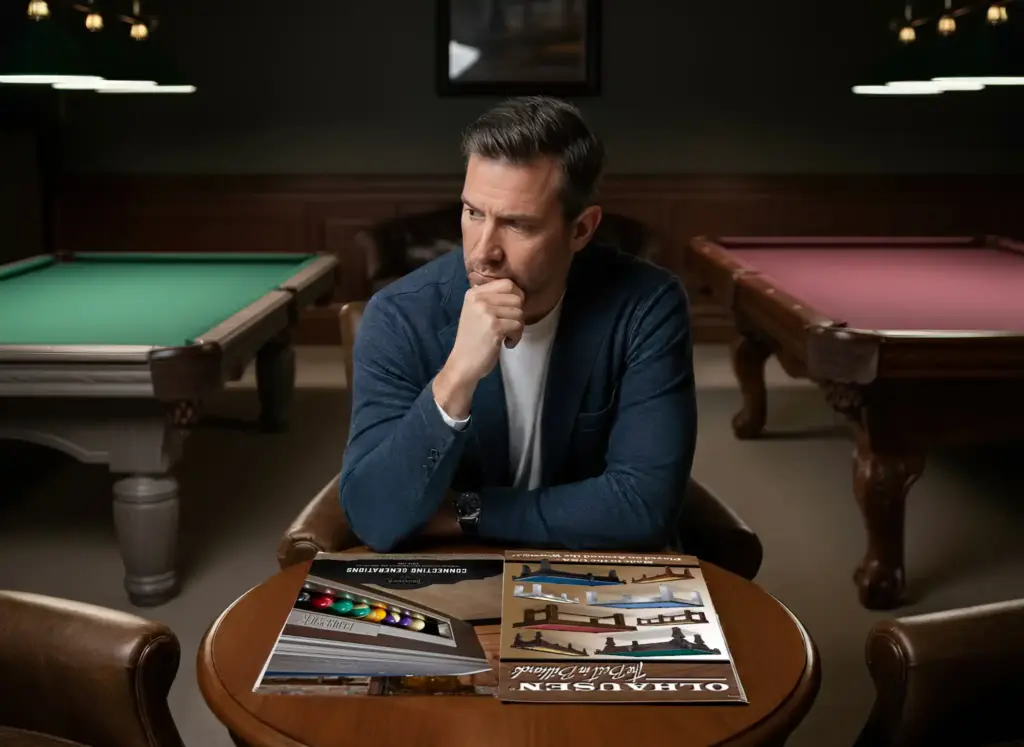Have you ever walked into a game room and seen a pool table that looks a little… different? Smaller, with obstacles in the middle and no side pockets? You’ve likely encountered a bumper pool table. While standard pool is a familiar pastime, bumper pool offers a unique twist on cue sports, presenting its own set of challenges and strategies. This article will dive deep into the distinctive world of bumper pool, exploring its origins, how to play, and what sets it apart from its more common cousin.
Key Takeaways
- Bumper pool is a unique billiard game played on a smaller, rectangular or octagonal table with bumpers as obstacles.
- The objective is to pocket your five coloured balls and one white ball into your opponent’s designated pocket.
- Strategies often involve precise bank shots and utilizing the bumpers to your advantage.
- The game has a distinct history, evolving as a compact alternative to traditional pool.
What is Bumper Pool and How Does it Differ from Standard Pool?
Bumper pool is a distinct variant of billiards played on a specialized table, typically smaller than a standard pool table. The most striking difference is the absence of side pockets and the presence of numerous obstacles, or “bumpers,” strategically placed across the playing surface. Unlike standard pool, where players aim to sink balls into any of the six pockets, bumper pool features only two pockets, located at opposite ends of the table. Each player is assigned one of these pockets as their target.
The game is generally played with ten balls, five of one color and five of another, plus two white cue balls. The primary objective is to pocket all of your colored balls and your designated white ball into your opponent’s pocket. This fundamental difference in objective and table layout leads to entirely different strategies compared to traditional pool, emphasizing precision bank shots and skillful navigation around the bumpers.
What are the Official Bumper Pool Rules?
Understanding the official bumper pool rules is crucial for mastering the game. While variations exist, the core principles remain consistent:
- Setup:
Each player receives five colored balls and one white cue ball. The balls are typically placed on specific spots at each end of the table, with the white cue ball positioned directly in front of the player’s designated pocket. One colored ball from each player is often placed on the white spot in front of their opponent’s pocket.
- Objective:
The goal is to be the first player to legally pocket all six of your balls (five colored, one white) into your opponent’s pocket.
- Starting the Game:
Both players shoot their white cue ball simultaneously from their end of the table, aiming to pocket it into the opponent’s hole. If both balls are pocketed, they are spotted back, and the shot is replayed. If only one is pocketed, that player continues. If neither is pocketed, the player whose ball is closest to their opponent’s pocket goes first.
- Gameplay:
Players take turns shooting. On each turn, a player must hit one of their own balls first. The cue ball must hit a colored ball before hitting a bumper.
- Pocketing Balls:
To legally pocket a ball, it must enter the opponent’s designated pocket. If a player accidentally pockets one of their own balls into their own pocket, it’s typically considered a foul, and the ball is often spotted back, or a penalty may apply.
- Fouls:
Common fouls in bumper pool include:- Hitting an opponent’s ball first.
- Hitting a bumper first before hitting one of your own balls.
- Pocketing the opponent’s ball (this usually results in the opponent getting to place one of their unpocketed balls into their pocket).
- Jumping a ball off the table.
- Touching any ball with your hand or clothing.
- Pocketing your own ball into your own pocket.
- Failure to hit any ball.
- If a foul occurs, the opponent typically gains possession of the cue ball and can place it anywhere on their half of the table, or a specific penalty may be enforced, such as the fouled player having to return a pocketed ball to the table.
- Winning:
The first player to successfully pocket all six of their balls into their opponent’s pocket wins the game.
Exploring Bumper Pool Strategy and Techniques
Mastering bumper pool requires a different approach than traditional pool. Here are some key bumper pool strategies and techniques:
- Bank Shots are Paramount:
Given the table’s design, direct shots are rare. Players must become adept at bank shots, utilizing the bumpers to guide their balls into the opponent’s pocket. Understanding angles and rebound physics is crucial.
- Utilize the Bumpers:
The bumpers aren’t just obstacles; they are tools. Learn how to use them to create intricate angles, set up future shots, or even block your opponent.
- Defensive Play:
Sometimes, the best offense is a good defense. Strategically positioning your balls to block your opponent’s access to their pocket or leaving them with difficult shots can be a highly effective bumper pool strategy.
- Pocketing Your White Ball:
Remember, your white cue ball must also be pocketed into your opponent’s hole. Often, players save this for last, using it as a final, decisive shot.
- Anticipate Rebounds:
Practice anticipating how balls will rebound off the bumpers. This skill is fundamental to planning multi-cushion shots and controlling the flow of the game.
- Patience and Precision:
Bumper pool is a game of precision, not power. Take your time, aim carefully, and focus on accurate execution.
The Unique History of Bumper Pool
The history of bumper pool is less documented than that of traditional billiards, but it is believed to have emerged as a more compact and accessible alternative to larger pool tables. Its exact origins are somewhat obscure, but the game gained popularity in the mid-20th century, particularly in homes and smaller recreational spaces where a full-sized pool table might not fit.
The design of the bumper pool table, with its central obstacles and end pockets, suggests an evolution aimed at creating a faster-paced game with unique challenges. It offered a different kind of strategic play, appealing to those who enjoyed billiards but sought a fresh experience or had space constraints. While it never reached the same global prominence as 8-ball or 9-ball, bumper pool has maintained a dedicated following, cherished for its distinctive gameplay and the social interaction it encourages. It’s a testament to the versatility and enduring appeal of cue sports.
Bumper Pool vs. Standard Pool: A Comparative Look
While both are cue sports, bumper pool and standard pool offer vastly different experiences.
| Feature | Bumper Pool | Standard Pool |
| Table Size | Smaller, often rectangular or octagonal | Larger, typically rectangular |
| Pockets | Two, at opposite ends | Six (four corner, two side) |
| Obstacles | Multiple “bumpers” on the playing surface | None on the playing surface |
| Number of Balls | 10 colored balls + 2 white cue balls | 15 colored balls (solids/stripes) + 1 white cue ball |
| Objective | Pocket your 6 balls into opponent’s pocket | Pocket your designated balls into any pocket |
| Primary Shot Type | Bank shots, caroms, precise angles | Direct shots, combination shots, safety play |
| Foul Penalties | Varies, often involves spotting balls or loss of turn | Varies (e.g., ball in hand, loss of turn) |
| Setup | Balls placed on specific spots, cue balls at ends | Balls racked, cue ball placed behind head string |
This table highlights that bumper pool is not merely a smaller version of pool but a game with its own distinct rules and strategic depth, making it a unique addition to any game room.
Frequently Asked Questions (FAQ)
What is the typical size of a bumper pool table?
- Bumper pool tables are generally smaller than standard pool tables.They often come in compact rectangular or octagonal shapes, with sizes commonly ranging from about 3½ × 5 feet to 4 × 6 feet—though exact dimensions can vary by manufacturer.
Can you play bumper pool with regular pool balls?
- No, bumper pool uses smaller balls than standard pool balls to navigate the bumpers and pockets effectively.
What happens if you pocket an opponent’s ball in bumper pool?
- If you accidentally pocket an opponent’s ball, it is typically considered a foul. The opponent usually gets to place one of their unpocketed balls into their designated pocket as a penalty.
Is bumper pool harder than regular pool?
- Many players find bumper pool challenging due to its emphasis on bank shots and navigating obstacles, which requires a different set of skills than direct potting in standard pool.
Conclusion
Bumper pool, with its compact design and unique rules, offers a refreshing and strategic alternative to traditional billiards. From its intriguing history to the intricate plays involving its signature bumpers, it’s a game that demands precision, foresight, and a keen understanding of angles. Whether you’re a seasoned player looking for a new challenge or a newcomer seeking a fun and engaging game for your home, understanding bumper pool opens up a new dimension of cue sports enjoyment.
Contact Hallmark Billiards for expert advice on game tables and accessories in the Greater Toronto Area.




